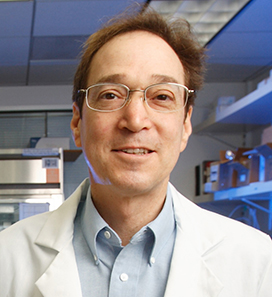Faculty

Michael R. Lieber, MD, PhD
Professor of Pathology and Gerontology
Overview
DNA double-strand breaks occur as part of the physiologic development of the immune repertoire in B and T lymphocytes. The Lieber Lab studies the manner in which these breaks are generated in a process called V(D)J recombination. Defects in the normal enzymes that generate these breaks can result in inherited forms of human severe combined immune deficiency (SCID). We study the biochemistry of how these proteins function, and we study how mutations in them result in SCID. Once DNA breaks are generated, they must be repaired. All cells of the body possess the ability to repair double-strand DNA breaks because all cells must deal with pathologic breaks in DNA that arise due to external radiation or due to free radicals of oxidative metabolism. The major pathway for repairing double-strand breaks in mammalian cells is called nonhomologous DNA end joining (NHEJ). If this pathway is defective in lymphocytes, then the breaks generated can not be repaired. Such defects also result in SCID. If the NHEJ pathway is defectve in all cells of the body, not only is the immune system affected, but the entire body is extremely vulnerable to ionizing radiation. Our laboratory has made substantial progress in defining proteins important in the NHEJ pathway. The first protein in the NHEJ pathway, Ku, binds at the broken DNA ends. The Artemis:DNA-PKcs complex is recruited to the DNA end by Ku. This binding activates the protein kinase activity of DNA-PKcs, which then phosphorylates Artemis and makes the Artemis:DNA-PKcs complex a potent nuclease for trimming DNA ends. Polymerase mu and lambda fill-in gaps, and polymerase mu can add nucleotides template-indepenently, like TdT. Finally, DNA ligase IV, XRCC4, and XLF form the ligation complex which ligates the double-strand break. We are interested in how all of these proteins carry out their functions and how their structure is important for this, and we are interested in identifying any other proteins that might be in th is pathway. We are also interested in how chromatin structure affects these proteins as they repair DNA breaks. The process of NHEJ is intrinsically imprecise. We suspect that this imprecision may contribute to the aging of somatic cells over time as well as to cancer. We are currently investigating this possibility using cell culture models, animal models, and analysis of human cells. Identification of inhibitors of NHEJ would be useful in cancer therapy and in improving gene targeting in human stem cells, and hence, we are trying to identify inhibitors of the pathway and individual components.
Mistakes of V(D)J recombination account for about 40% of nonHodgkin’s lymphoma. We study how the normal V(D)J recombination process goes awry. Specifically, why do some ends fail to join properly, and why do some sites adjacent to oncogenes get cleaved inadvertently. The inadvertent cleavage of some sites may be due to an altered DNA structure at those sites. We are trying to understand the extent to which such DNA structural deviations contribute to the fragility of such common chromosomal translocation hotspots.
Class switch recombination is a second developmentally programmed gene rearrangement process in the vertebrate immune system, and it occurs in B cells at the Ig heavy chain locus. Class switching is the process that results in IgM being converted to IgG, IgA, or IgE. Humans borne with defects in class switching die early in life because they can not make IgA for protection of their lungs. The enzyme that initiates the class switch gene rearrangement process is a cytidine deaminase, called AID, that only functions on single-stranded DNA. We have focused on how the class switch recombination regions become single-stranded. Upon transcription, the RNA remains associated with the template DNA strand, resulting in an R-loop structure. The R-loop structure provides a substantial amount of single-stranded DNA at which the AID enzyme can act. We are interested in determining the factors that favor R-loop formation. In some lymphomas, the class switch recombination process goes awry, just as in V(D)J recombination. We are also studying these events.
In summary, the Lieber lab focuses on how physiologic and pathologic gene rearrangements function in the immune system and in cancer and aging.
Email: lieber@usc.edu
Office Phone: +1 323 865 0568

